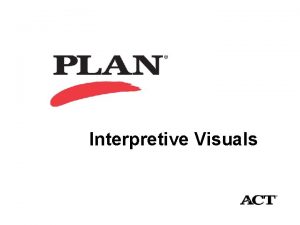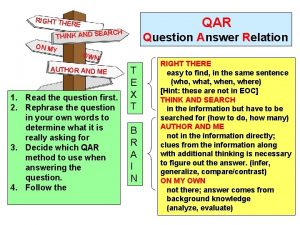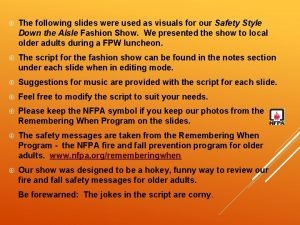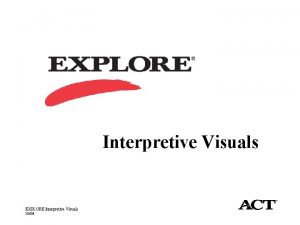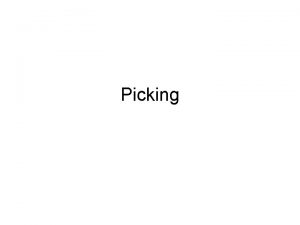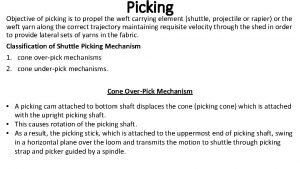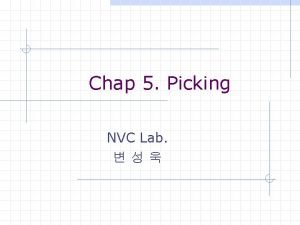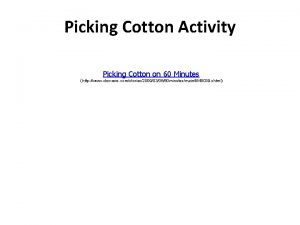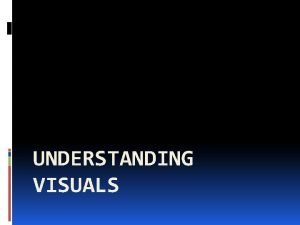Picking your visuals Some tips on which visuals


















- Slides: 18

Picking your visuals Some tips on which visuals to use (and which not to use) and when

Consider These Before Beginning Content Message you want to convey What visual is the most effective Content

Selecting Your Visual: 4 Categories Relationship between numbers Relationship over time Relationship between entities Person, place, object

Relationships Between Numbers • There are several types of visuals for number comparisons • Bar charts, line charts, histograms, box plots, pie charts and scatter plots are just a handful • Nature of the values, situation and audience are important things to keep in mind

Relationships Between Numbers Chart title 35 Amount of Sugar in Certain Foods Data label 33, 2 30, 3 30 28, 9 25 Y-axis label Percent Sugar 21, 4 20 15 11, 8 10 8, 8 9, 2 Ketchup Peanut Butter 5 Axes labels 0 Chocolate Bar Ice Cream Chocolate Cake Soda Crackers

Relationships Between Numbers Utah Smoker and Drinker rates by County Legend Excessive Drinker Rate Smoker Rate Grafton Axes labels Coos Cheshire Carroll Belknap Data label 0 5 10 15 20 25 30 35

Horizontal vs Vertical charts • While horizontal and vertical bar graphs are often interchangeable, there are some defining differences that make one type more suitable in certain situations. • Use a vertical bar graph if: • You want to display time series data • Your axes labels are short • You want to emphasize a magnitude of change/disparity • Use a horizontal bar graph if: • Your axes labels are long (i. e. countries) • There are few (or no) time periods

Don’t use 3 -D charts When considering a 3 -d chart, ask yourself what the extra dimension adds to your presentation. Probably nothing. More than likely, the 3 -d aspect is unnecessary and distracting, taking away from the impact of your visual. 3 -D chart (gratuitous) 5 4, 5 4 3, 5 3 2, 5 2 1, 5 1 0, 5 0 Category 1 Category 2 Series 1 Category 3 Series 2 Series 3 Category 4

Caution With Pie Chart While pie charts are popular in the business world, it’s generally a good idea to stay away from using them, unless your chart will include only two values. This is because it’s difficult for the human eye to easily detect the discrepancy in values when there are several sections and a pie chart labeled with numbers is messy and difficult to read. A bar graph or other type of graph is generally much more effective at conveying the difference. 1 st Qtr 2 nd Qtr 3 rd Qtr 4 th Qtr

How to Create These Visuals? These visuals can be created in Excel or Power. Point. While both are effective, Power. Point offers more control. Why? While Excel is intuitive and interacts directly with your data source, once the visual is exported, there is little you can do to manipulate your visual.

Components of a total/whole A stacked bar chart is usually your best bet when you want to convey parts of a whole or a segment’s relationship to the overall population. The example to the right depicts a company’s sales in the electronics department compared to all other departments. Notice how the figures are in percentages and there are four quarters. Stacked Bar Chart 100% 90% 80% 70% 60% 50% 40% 30% One thing to keep in mind when building stacked bar charts is the number of comparisons you want to make. Things can get messy if you try to compare three or more segments in a single column. 20% 10% 0% Q 1 Q 2 Electronics Q 3 Other Q 4

Depicting Trends As with visuals that compare values, there are several ways to display trends. Area Chart 35 30 25 20 The line graph and area chart are the two go-to options, but there are other visuals to choose from as well. 15 10 5 0 1. 5. 2002 1. 6. 2002 1. 7. 2002 Series 1 Series 2 1. 8. 2002 1. 9. 2002

Area charts: How and When Area charts represent change over time. Unlike line charts, area charts are great at visually representing volume. Area charts are great for communicating overall trends as opposed to individual values. New Contacts, By Source 60 50 40 The example to the right depicts the number of new contacts a company makes per month. It is comparing two contact types: organic search and social media. Notice how the overall area is a combination of the two categories. As you can see, organic search represents a higher volume of contacts and is a larger proportion of the total contacts. 30 20 10 0 January February Organic Search March Social Media April

Depicting Trends This line graph, copied from an online source, is effective at conveying the change of prices over a long period of time. Line graphs are a great way to depict fluctuations over long periods of time. Source: http: //www. cleanri. com/post_line-chart_102/

Communicating Entities Through Sequences Need to depict a relationship amongst entities? Smart Art is a good place to look. There is a wide variety of Smart Art available which allows you to depict a variety of relationships in a way that is simple and easy to understand, yet elegant and aesthetically pleasing.

Depicting Objects, Places, or Things Title of Picture You’ve probably heard the old cliché a picture is worth 1, 000 words. While the expression may be overused, it’s true. Often times the best way to communicate something is by simply showing it to your audience. Cliffs of Moher This photo, copied and pasted from Google Images, depicts the Cliffs of Moher, a famous tourist destination in Western Ireland Caption for Picture

Write a headline • Before selecting the visual, come up with a headline • Put yourself in the shoes of a newspaper editor and pretend you have only a few words to catch your audience’s attention • The headline should convey one clear message

In Closing While there are other visuals available, this presentation provides you a list of some of the most commonly used visuals and when they are most appropriate. Other things to keep in mind: • Be sure to properly label your visuals • Always think before you build • You are a storyteller—your visuals are one way you tell the story
 Picking yourself up by your bootstraps
Picking yourself up by your bootstraps Here is some tips
Here is some tips Here are some tips
Here are some tips Interpretive visuals
Interpretive visuals Toilet training visual aids
Toilet training visual aids Alachua visuals llc
Alachua visuals llc Interpretive visuals
Interpretive visuals Qar visuals
Qar visuals Non projected visuals
Non projected visuals Qar visuals
Qar visuals Power bi custom visual development
Power bi custom visual development Power bi custom visuals programming language
Power bi custom visuals programming language Use developer tools to create custom visuals power bi
Use developer tools to create custom visuals power bi As visuals
As visuals They say it only takes a little faith to move a mountain
They say it only takes a little faith to move a mountain God when you choose to leave mountains unmovable
God when you choose to leave mountains unmovable Ice cream è countable or uncountable
Ice cream è countable or uncountable Contact vs noncontact forces
Contact vs noncontact forces Some say the world will end in fire some say in ice
Some say the world will end in fire some say in ice






